by Ivah Steenwyk
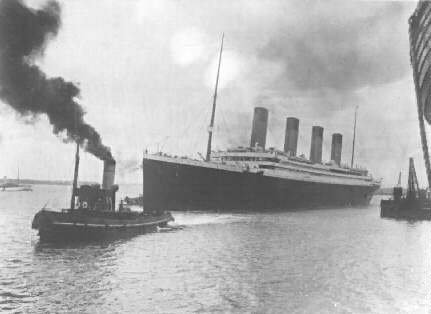
This is the RMS Titanic leaving its first port.
It all started on a summer night in 1907. Bruce Ismay and Lord James Pirrie, partners in the firm of Harland and Wolff (a British ship building company), were discussing the creation of two new giant passenger ships, to be called the "Olympic" and the "Titanic." The Titanic and the Olympic were to be almost identical except in size, the Titanic was to be 1004 gross tons larger and a bit more luxurious. The focus of these new liners would be speed, luxury, and comfort. They had to be fast enough to get from England to New York in about a week.
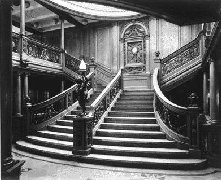
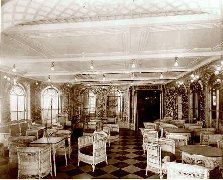
This is the grand staircase that lead into the dinning room.
The Titanic would have a 220-foot-high gantry, or framework, the largest in the world. Their First Class portions of the ships would have huge lounges, a smoking room, a large reception room, and a reading room. The Dinning Room on the Titanic was to be three decks high and topped with a glass dome. In the lower part of the ships, there was to be a Turkish bath and swimming pool. There was also to be a gymnasium which was on the top deck of the Titanic. On the Titanic there were to be three elevators for First Class passengers and one for the use of Second Class passengers. In the next four years both of the ships were built.
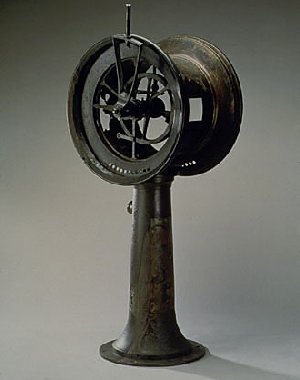
Divers recovered this telegraph used to signal from the bridge
to the engine room speed and direction adjustments.
Many people showed up for the launch on May 31, 1911, of the Titanic. They watched the hull move down the ways. A "way" is a shallow ramp which leads down to the water and is used after the workers finish the hull work on a ship. Once the hull is launched, they move it into deeper waters where they finish it. The Titanic traveled a length of 900 feet before coming to a rest in her fitting-out basin. A "fitting-out basin" is where the boat sits after being launched down the way, where the ship builders do their finishing touches.
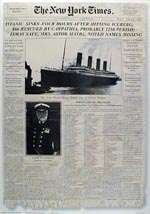
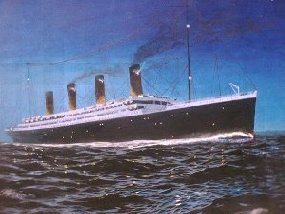
Pictures and articles about the Titanic were popular before its maiden voyage.
It took ten months to complete her interiors. Finally, on April 10, 1912, the largest ship in the world set sail from Belfast. The Captain in charge of the ship was E.J. Smith. While leaving the port, the Titanic narrowly escaped a collision with the liner New York. However, soon the Titanic reached the English Channel and arrived at her first port in Chebourg, France, around 6:30 PM. There she took aboard mail and about 247 more passengers. The Titanicís last stop was at the Port of Liverpool, where she took on 120 more passengers with more mail, then set sail for New York.
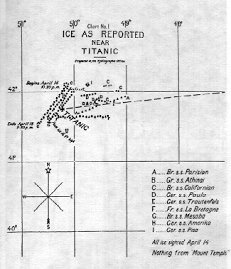
This is a map of the position of the ice around the Titanic.
On her fourth day at sea, Sunday, April 14, at nine in the morning the mighty ship received their first warning of icebergs. The ships Carolina, Noordam, Baltic, and the Amerika all gave warnings to the Titanic telling them that they were sailing into an area of heavy icebergs. Most people on board were not afraid, they believed that the ship was unsinkable.
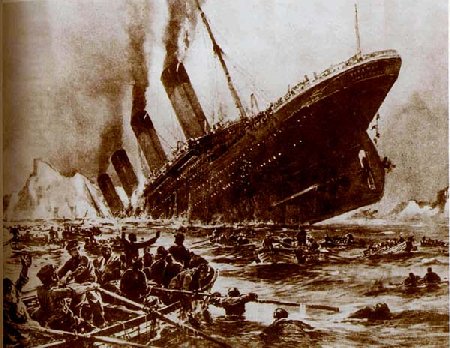
A drawing of the unsinkable ship as it sank.
The last ice warning was received at 9:40 PM from the Mesaba. The nearest ship to the Titanic, the Californian tried to signal her, but the Titanicís wireless officer named Phillips told the Californian to shut up because he was busy. Many people believe that it was those very words that sealed the fate of the Titanic. The Californian's wireless operator then turned off his radio and went to bed.
Frederick Fleet and Lee were the watchers in the crows nest of the Titanic who first spotted the giant berg. They rang the bell three times and yelled, "Iceberg dead ahead!" The Titanic was on a collision course with the iceberg.
First Officer William Murdoch ordered the shipsí engines stopped, reversed, and then the mighty ship tried to turn hard to port to miss the berg. In doing this, the ship missed hitting the ice berg head on, but would scrape along the side of the ice instead, which probably caused more damage than hitting it straight on would have.
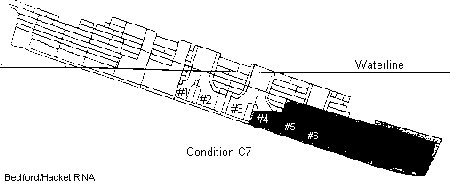
This picture shows the diagram how the ship sank.
The Iceberg scraped below the shipís water line and damaging at least five or six watertight compartments. Water went into the first five compartments. The Titanicís design was such that it was unable to continue to float with more than the first four compartments flooded. At this point, the ship had only about an hour and a half before the it went down.
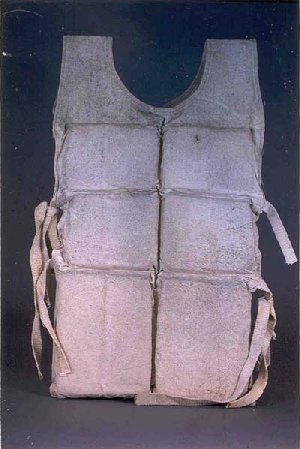
Life vest keep you a float, but
won't help you against the cold water temperatures.
Sailors walked from door to door telling passengers to put on life vests because the ship was sinking. After midnight, Captain Smith ordered the lifeboats ready. At first, only women and children were allowed into the boats. There were not enough lifeboats for all the passengers on board and in the panic many lifeboats were leaving only half full. Soon the stern started to rise out of the water and people were running frantically everywhere. They started to jump off hoping that they could somehow swim to safety.
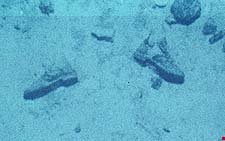
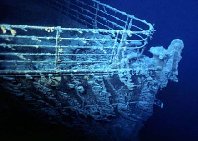
Today someoneís boots still sit on the sand beneath the stern of the Titanic.
At 2:17 AM the Titanicís stern had risen out of the water and stood at a 90 degree angle for a minute and then the "unsinkable" Titanic plunged into the icy water.
Of the 2,200 people who were on board the Titanic, 1,523 people died on that fateful night. They died because there were not enough life boats to hold all the passengers, and the freezing waters quickly froze them to death. Because everyone was so sure that the mighty ship would not sink, they had not prepared for such a disaster. It did help us to learn from our experiences. We now have laws that ships are only allowed to go at certain speeds, to have enough life boats and safety devices for all passengers, and we now have boats patrolling the waters at all times for icebergs.
"Infoplease.com" @ http://www.infoplease.com, 06/8/00
"The Dream" @ http://www.geocities.com/Area51/Zone/1764/dream.html , 05/08/00
"That Fateful Day" @ http://www.geocities.com/Area51/Zone/1764/day.html, 05/08/00
"Maiden Voyage" @ http://www.geocities.com/Area51/Zone/1764/maiden.html , 05/08/00
"Sank" @ http://home.flash.net/~rfm/sinking/sank.html, 05/08/00
"Sinking" @ http://www.geocities.com/Area51/Zone/1764/sinking.html, 05/08/00
Picture #1 - "This is the RMS Titanic leaving its first port." from: http://www.geocities.com/capecanaveral/Hangar/7574/titanic.htm
Pictures #2 and 3 - "This is the grand staircase leading into the dinning room" from: http://www.geocities.com/Athens/Oracle/6579/Titanic.htm
Picture #4 - "This is a telegraph that signaled the engine room" from: http://www.titanic-online.com/gallery/artifacts/telgrph.htm
Pictures #5 and 6 - "Pictures and articles about the Titanic were popular before its maiden voyage." from: http://www.titanic-online.com/gallery/artifacts/telgrph.htm
Picture #7 - "This is a map of the position of the ice around the Titanic" from: http://www.geocities.com/Athens/oracle/6579/Titanic.htm
Picture #8 - "A drawing of the unsinkable ship as it sank." from: http://www.si.edu/postal/titanic/sinking.html
Picture #9 - "This picture shows the diagram how the ship sank." from: http://home.flash.net/~rfm/SINKING/Sank.html
Pictures #10 and 11 - "Today someoneís boots still sit on the sand beneath the stern of the Titanic." from: http://www.titanic.cc/titanic.htm